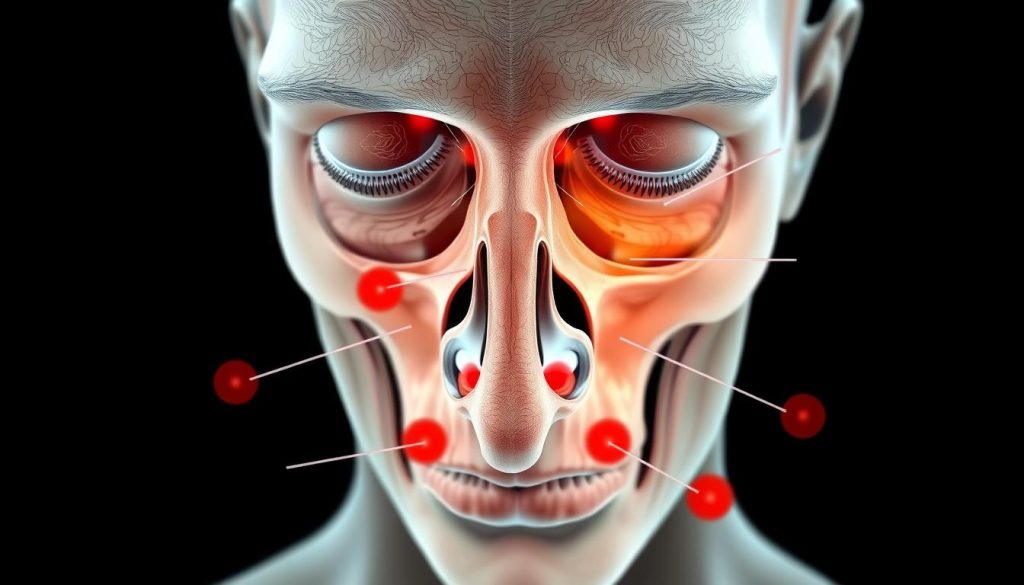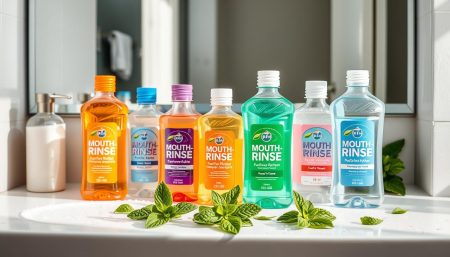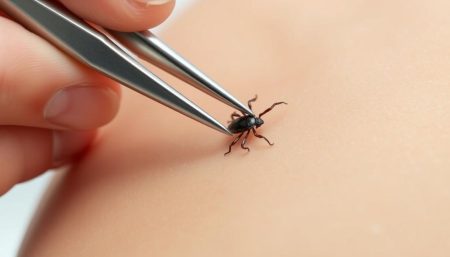Feeling pain inside your nose is more than just a nuisance; internal nose pain can signal serious health issues. In the United States, many people suffer from this pain. It can be anything from a minor annoyance to a major problem that affects daily life.
Nasal discomfort is unique because it can mess with your focus and overall well-being. This introduction will help you understand what causes internal nose pain and the treatment options for nasal discomfort. We’ll look at the data and advice from otolaryngology experts. They’ll guide us on how to tackle this common issue.
We’ll cover everything from symptoms to the impact of allergies and the environment. We’ll also talk about important lifestyle changes. Stay with us to learn more about managing internal nose pain with different treatment options for nasal discomfort.
Exploring the Different Types of Internal Nose Pain
It’s important to know the different types of internal nose pain to get the right treatment. This section will cover acute rhinosinusitis and chronic rhinosinusitis discomfort. We’ll also look at sinus pain and intranasal soreness in detail.
Acute vs Chronic Rhinosinusitis Discomfort
Acute rhinosinusitis comes on quickly after a cold or allergy. It’s a short-term inflammation that usually goes away in a few weeks. Chronic rhinosinusitis, on the other hand, lasts more than 12 weeks. It needs a more careful treatment plan.
Comparison of Sinus Pain and Intranasal Soreness
Sinus pain feels like a throbbing or pressure in your forehead, cheekbones, and nose bridge. Intranasal soreness is an irritation or tenderness inside your nose. It can get worse with nasal sprays or irritants in the air.
| Condition | Characteristics | Duration | Common Symptoms |
|---|---|---|---|
| Acute Rhinosinusitis | Sudden onset, related to infections or allergies | Less than 4 weeks | Nasal congestion, facial pain, sinus pressure, runny nose |
| Chronic Rhinosinusitis Discomfort | Persistent inflammation, often with unknown etiology | Exceeds 12 weeks | Nasal blockage, postnasal drip, reduced sense of smell, ongoing discomfort |
| Sinus Pain | Pressure or pain in sinus regions | Can be acute or chronic | Face, forehead, or cheek pain; worsens with bending forward |
| Intranasal Soreness | Irritation inside the nose | Varies | Nasal dryness, stinging or burning sensation inside the nose |
Diving Into the Anatomy: Understanding Nasal Cavity Discomfort
The nasal cavity is a complex structure that plays a critical role in not just breathing but also in our sensory system. Understanding the anatomy of the nasal passages and nasal cavity inflammation helps us better comprehend the different types of nasal cavity discomfort people experience.
The Structure of the Nasal Passages
The nasal passages are made up of various components including the septum, sinuses, turbinates, and mucous membranes. Each part has a unique function, contributing to the overall effectiveness of the nasal cavity. Key to breathing, filtering air, and detecting odors, the anatomy of the nasal passages is meticulously designed to support multiple senses and respiratory functions.
How Nasal Cavity Inflammation Affects Us
Nasal cavity inflammation can lead to significant discomfort and affect daily activities. Symptoms like congestion, pressure, and pain are typical and can escalate if the inflammation spreads to surrounding structures such as the sinuses. This inflammation can be triggered by various factors such as allergies, infections, or environmental irritants.
Understanding the impact of these symptoms is key for timely diagnosis and treatment. It helps alleviate discomfort and prevent further complications.
| Part of Nasal Passage | Function | Common Issues |
|---|---|---|
| Septum | Divides nasal cavity into two nostrils | Deviations, swelling |
| Sinuses | Produce mucus, filter and humidify air | Infections, sinusitis |
| Turbinates | Warm and moisten air | Enlargement, inflammation |
| Mucous Membranes | Protect inner nasal walls, trap particles | Dryness, excessive mucus production |
By delving into the anatomy of the nasal passages and exploring how issues like nasal cavity inflammation occur, individuals can better understand the mechanisms behind nasal cavity discomfort. This knowledge helps in prevention and treatment options.
Common Causes Behind Internal Nose Pain
Knowing the causes of internal nose pain is key to finding the right treatment. This pain, linked to rhinology issues, can really affect your daily life and how well you feel.
- Infections like sinusitis or rhinitis cause inflammation and pain in the nasal cavity.
- Structural problems, like a deviated septum, can lead to long-term nose pain.
- Allergic reactions also trigger swelling and irritation inside the nose.
Rhinology pain is often misunderstood or misdiagnosed. It’s important to look into the details. Here’s a table showing the different causes of internal nose pain and their symptoms:
| Cause | Symptoms |
|---|---|
| Bacterial Sinusitis | Persistent pain, nasal discharge, blocked nose |
| Deviated Septum | Difficulty breathing, facial pain, frequent nosebleeds |
| Allergic Rhinitis | Sneezing, itchy nose, watery eyes |
Different causes can make pain worse and last longer. Getting a correct diagnosis is vital. Knowing what causes your pain can help you manage it better. A healthcare provider who specializes in rhinology can offer the best help.
Signs and Symptoms Associated with Nasal Congestion Pain
It’s important to know the signs and symptoms of nasal congestion pain. This helps identify conditions like sinusitis. We’ll look at the main signs and secondary symptoms to watch for.
Recognizing Sinusitis Pain
Sinusitis pain is a key sign of inflammation in the sinuses. It’s a sign of sinusitis. People with sinusitis often feel a constant ache or pressure in their cheeks, eyes, and forehead.
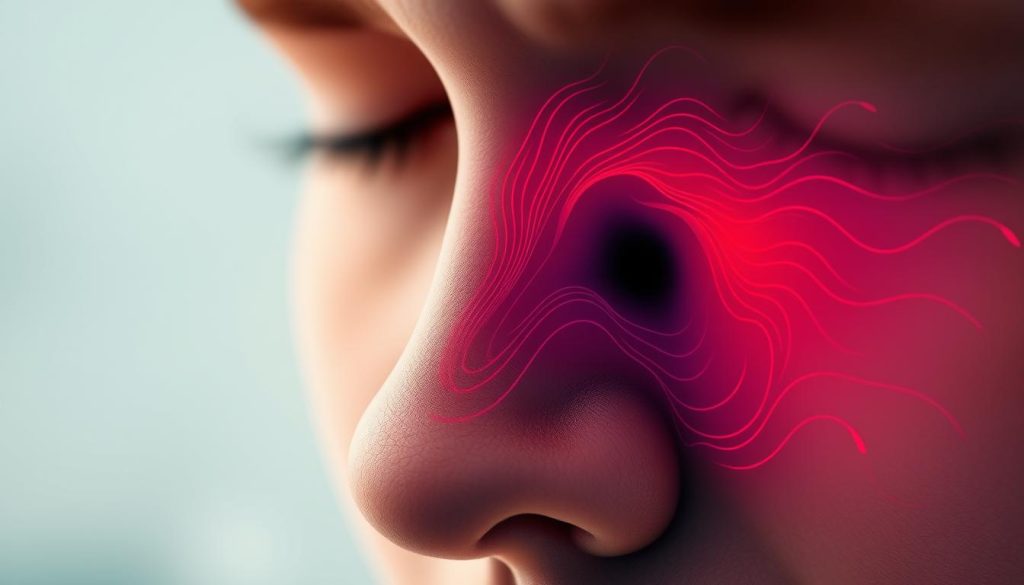
Identifying Other Signs of Inner Nasal Discomfort
There are other symptoms of inner nasal discomfort to be aware of. These include:
- Nasal congestion leading to difficulty breathing through the nose.
- Excessive production of mucus, which might be clear, yellow, or green.
- Postnasal drip, which can cause a sore throat or cough.
- Diminished sense of smell and taste.
Spotting these symptoms early can help get timely and effective treatments. This can reduce the risk of complications from nasal congestion pain and sinusitis.
Internal Nose Pain: Key Factors in Diagnosis
Finding the right diagnosis for internal nose pain is key to effective treatment. It depends on two main things: a thorough medical history and a detailed physical examination.
Looking at past health records and experiences helps doctors in rhinology pain detection. For example, a history of allergies might point to allergic rhinitis. This is explained in this allergic rhinitis guide.
Importance of Medical History in Diagnosing Rhinology Pain
A detailed medical history is the foundation of diagnosing rhinology issues. It gives clues about the cause and triggers of nasal pain. Doctors look at past treatments, symptom duration, and patterns to guess the cause of pain.
Physical Examination and the Detection of Nasal Cavity Discomfort
A thorough physical examination is vital to confirm initial guesses. Doctors visually check the nasal cavity and perform tests. This helps find physical issues like swellings or structural problems that cause pain.
Together, the medical history and physical examination help doctors make a complete diagnosis. They guide the treatment for internal nose pain.
When Should You Worry About Internal Nose Pain?
Internal nose pain might seem like a small issue, but some signs are serious. Knowing the red flags for nasal conditions and when to seek medical advice for internal nose pain is key. It helps catch health problems early.
Red Flags Indicating More Serious Conditions
Some symptoms are warning signs for serious nasal or sinus issues:
- Severe or ongoing pain that doesn’t get better with common meds
- Swelling around the eyes or nose with a lot of pain
- Yellow or green discharge, which means an infection
- Fever, which could mean an infection is spreading
- Sudden vision changes or eye swelling
When to Seek Professional Medical Advice
See a doctor if you have any of these symptoms. Doctors are key in treating serious sinus infections or nasal problems.
- Long-lasting symptoms over 10 days
- Symptoms get better then get worse
- Noticeable loss of smell or taste
- Severe headache or facial pain that doesn’t go away with usual meds

Knowing these warning signs and when to get help is vital for your health. Early treatment of serious nasal issues can stop bigger problems later.
Home Remedies to Alleviate Intranasal Soreness
Many people look for home remedies for intranasal soreness to feel better. We’ll share some natural ways and common ingredients that help. These methods are easy to do at home and have few side effects.
- Saline Nasal Spray: A homemade saline solution can moisturize your nose and remove allergens. Mix one teaspoon of salt with two cups of warm distilled water for a gentle spray.
- Steam Inhalation: Breathing in steam can clear your nose and ease soreness. Just cover your head with a towel over a bowl of hot water.
- Warm Compress: A warm compress on your nose and forehead can ease sinus pressure and discomfort.
- Herbal Teas: Drinking warm teas like ginger, peppermint, or chamomile can reduce inflammation and soothe soreness. They have natural anti-inflammatory properties.
Many people find relief with these natural methods. They can easily fit into your daily routine. Here’s a table showing some common ingredients used in home remedies for intranasal soreness and their benefits.
| Ingredient | Benefits | Application Method |
|---|---|---|
| Sea Salt | Clears nasal passages, reduces swelling | Saline Nasal Spray |
| Ginger | Anti-inflammatory, soothes irritation | Herbal Tea |
| Chamomile | Anti-inflammatory, reduces histamine reactions | Herbal Tea |
| Peppermint | Clears sinuses, cooling effect | Steam Inhalation |
Using these home remedies for intranasal soreness can help you feel better. Just remember to check if you’re allergic to any ingredients before trying them.
Professional Treatment Options for Nasal Cavity Inflammation
Dealing with nasal cavity inflammation can be a complex issue. It often needs specialized attention. For those with chronic rhinosinusitis, knowing the treatment options is key. This section looks at both medicines and procedures doctors might suggest.
Medications Prescribed for Relieving Sinus Pain
Medicines are often the first step to ease discomfort from nasal cavity inflammation. These treatments aim to reduce inflammation, ease pain, and clear nasal passages. Common medicines include:
- Nasal corticosteroids: Such as fluticasone, budesonide, or mometasone, help to decrease inflammation directly in the nasal passages.
- Antibiotics: If your sinusitis is bacterial, a doctor may prescribe an antibiotic to combat the infection.
- Decongestants: Oral or nasal sprays such as phenylephrine or pseudoephedrine, which help reduce nasal congestion.
- Saline nasal irrigation: A mild saline solution can be used to rinse your nasal passages, helping to keep them moist and reduce inflammation.
These medicines are often the first step in treating nasal cavity inflammation before considering more invasive measures.
Interventional Procedures for Chronic Rhinosinusitis Discomfort
When medicines don’t work, doctors might suggest interventional procedures. These are key for severe or chronic rhinosinusitis:
- Endoscopic Sinus Surgery: A minimally invasive surgery that uses a nasal endoscope to remove blockages and improve sinus drainage.
- Balloon Sinuplasty: A no-cut option where a small, flexible balloon catheter is inserted into sinus passages to gently expand them, facilitating better drainage.
These procedures can offer significant relief. They show the advanced options in modern ENT treatment. Recovery times vary, but most patients see big improvements in symptoms after these procedures.
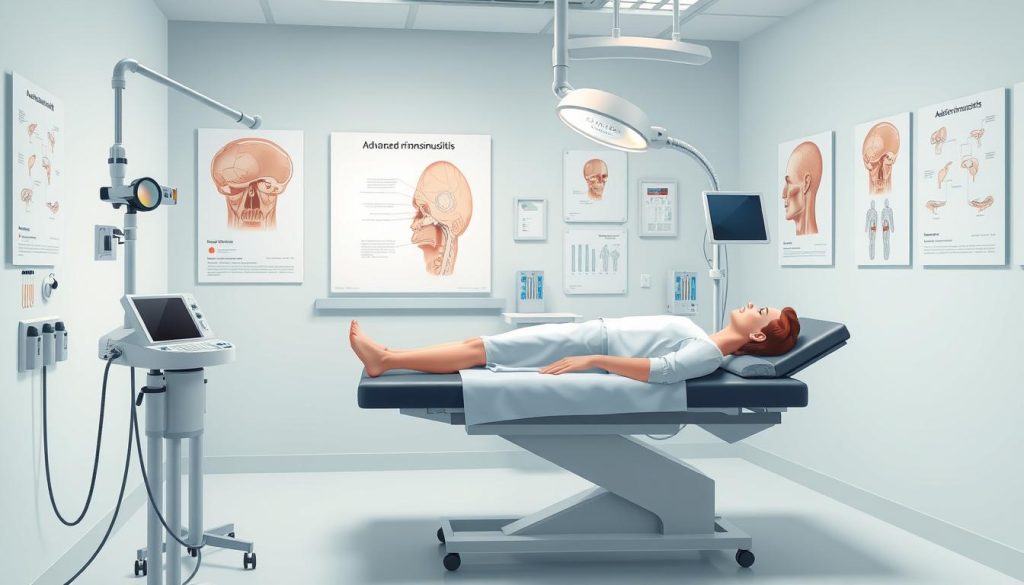
The Role of Allergies in Chronic Rhinosinusitis Discomfort
Allergies affecting rhinosinusitis play a big role in making chronic rhinosinusitis harder to manage. Studies show that chronic rhinosinusitis and allergies are closely linked. Allergies make the inflammation in the sinuses worse. Knowing this helps doctors find better ways to treat it.
Chronic rhinosinusitis makes the sinuses inflamed for a long time. This can really lower a person’s quality of life. When allergies are added, the inflammation gets even worse. Studies say that treating allergies is key to easing chronic rhinosinusitis symptoms.
- Reduction in nasal congestion
- Decrease in sinus pressure
- Improved nasal drainage
Research shows that allergies can make chronic rhinosinusitis worse. Finding and avoiding allergens is very important.
| Allergic Trigger | Impact on Rhinosinusitis |
|---|---|
| Pollen | Increases sinus inflammation during high pollen seasons |
| Dust Mites | Contributes to year-round sinus issues |
| Pet Dander | Triggers flare-ups in sensitive individuals |
Dealing with allergies needs a two-step plan. First, use antihistamines or nasal sprays to control the allergy. Second, avoid things that cause allergies. This helps a lot in managing allergies affecting rhinosinusitis and stopping chronic rhinosinusitis from getting worse.
It’s very important to treat allergies when treating chronic rhinosinusitis. By focusing on both allergies and inflammation, doctors can give patients better care.
Impact of Environmental Factors on Internal Nose Pain
The environmental impact on internal nose pain is a big health worry that many overlook. Poor air quality can hurt the sensitive tissues in our noses, causing pain and health problems. It’s key to know this to protect our nasal health.

How Air Quality Can Exacerbate Nasal Cavity Discomfort
Pollutants and allergens like smog, dust, and industrial emissions harm our noses. They make the mucous membranes swell, causing blockage and pain. In cities, these pollutants are more common, leading to more nose pain and symptoms.
Preventative Measures to Reduce Intranasal Soreness
To lessen environmental impact on internal nose pain, we need to make some changes. Here are some preventative measures for nasal health:
- Using air purifiers in homes to remove harmful particles and allergens.
- Checking air quality indexes and staying indoors when pollution is high.
- Adding more plants and trees in cities to clean the air naturally.
- Cleaning homes and workplaces regularly to cut down dust and allergens.
- Keeping indoor humidity levels right to avoid dryness that irritates the nose.
By tackling the environmental impact on internal nose pain, we can improve our nasal health and overall well-being.
Lifestyle Adjustments to Prevent Recurrence of Nasal Congestion Pain
Keeping your nose healthy is more than just treating it. It’s about making daily choices that help you stay well. Eating right and exercising can help prevent nasal congestion and improve your sinuses.
Diet and Hydration: Keys to Minimizing Sinusitis Pain
Eating the right foods is key to keeping your nose healthy. Foods that fight inflammation can help reduce swelling and ease sinus pressure. Drinking enough water also helps by making mucus thinner and easier to drain.
- Omega-3 Fatty Acids: Found in fish like salmon and seeds such as flaxseeds, omega-3s help reduce nasal inflammation.
- Vitamins C and E: Citrus fruits, almonds, and green leafy vegetables boost the immune system and protect the body against sinus infections.
- Hydration: Drinking plenty of water, herbal teas, and broth helps keep the nasal passages hydrated and mucus flowing smoothly.
Exercises and Techniques to Enhance Nasal Health
Exercising regularly can improve your health and help your nose work better. Techniques like nasal irrigation and breathing exercises can also help prevent nasal congestion pain.
- Nasal Irrigation: Using a saline solution can flush out irritants and reduce the thickness of nasal mucus, making it easier to drain.
- Breathing Exercises: Practices such as pranayama yoga can increase lung capacity, improve airflow, and strengthen the respiratory system.
- Physical Exercises: Simple activities like walking or cycling can boost blood circulation and immune function, which is beneficial for sinus health.
| Dietary Element | Benefits | Recommended Intake |
|---|---|---|
| Omega-3 Fatty Acids | Reduces inflammation in nasal passages | 2-3 servings of fish per week or supplements as advised by a healthcare provider |
| Hydration | Keeps mucus membranes moist and mucus thin | 8-10 glasses of water daily |
| Vitamin C | Strengthens immune defense against sinus infections | 1-2 servings of citrus fruits daily |
Navigating Chronic Conditions that Cause Inner Nasal Discomfort
Chronic nasal discomfort often needs a deep understanding and specific management plans. Deviated septum and autoimmune disorders are key factors in ongoing nasal pain.
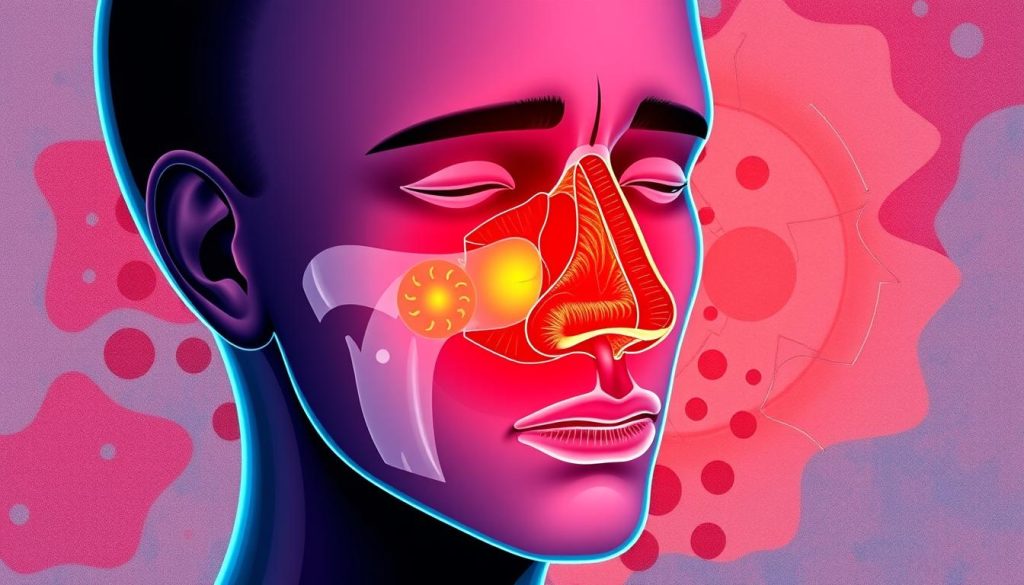
Deviated septum is a common issue where the thin wall between nasal passages is off-center. This can block airflow and cause breathing problems and discomfort. It can also lead to sinus infections, making nasal cavity inflammation worse.
Understanding the Impact of Deviated Septum on Internal Nose Pain
The severity of a deviated septum affects how much pain you feel. Signs include constant nasal congestion, facial pain, and noisy breathing at night.
Autoimmune Disorders and Nasal Cavity Inflammation
Autoimmune disorders also cause chronic nasal inflammation. They make the immune system attack healthy nasal tissues, leading to swelling and pain. Conditions like lupus and rheumatoid arthritis often include nasal symptoms.
Managing these conditions involves medication to reduce inflammation. For deviated septum, surgery might be needed. It’s important to see healthcare experts who know how to treat nasal issues.
Advanced Rhinology Pain Relief: From Surgery to Alternative Therapies
Dealing with rhinology pain relief involves many options. This includes surgical interventions and alternative therapies for nasal pain. Thanks to new medical discoveries, people can find treatments that match their health needs and likes.
Surgery is key for serious cases. New, less invasive surgeries can help a lot and heal faster than old methods. At the same time, more people are looking into non-surgical ways to manage pain. This includes herbal remedies, acupuncture, and special nasal sprays. These options help with pain without surgery.
- Balloon Sinuplasty
- Endoscopic Sinus Surgery
- Cryotherapy for Nasal Tissues
Doctors pick surgical interventions based on each patient’s pain and body. This ensures the best results and better life quality.
On the other hand, gentler methods like saltwater rinses, essential oil breathing, and changing what you eat are becoming popular. These can help ease symptoms and boost nasal health slowly.
- Nasal irrigation with saline solutions
- Steam inhalation with or without essential oils
- Herbal supplements like butterbur or spirulina
Using alternative therapies for nasal pain with regular treatments can help even more. Always talk to a doctor before trying these, to make sure they work well with other treatments.
The Importance of Follow-Up Care in Managing Internal Nose Pain
Dealing with internal nose pain is key to keeping your nose healthy. But, it’s not just about the first treatment. Follow-up care for nasal pain is vital, whether you’ve had surgery or started new meds. These check-ups help make sure the pain is being handled right and let doctors tweak your treatment if needed.
Regular visits are like a safety net. They help track your progress, catch any problems early, and prevent them from getting worse. This is how you keep your nose in top shape.
Staying committed to follow-up care is key to managing internal nose pain. Each person’s needs are different, so follow-up care is tailored to you. It might include more doctor visits, tests, and advice on how to live better.
Going back to your doctor lets you talk about any ongoing pain or new issues. It’s also a chance to see if the treatments are working. For long-term conditions, regular check-ups are essential for adjusting to changes and keeping your quality of life high.
Stick to the aftercare plan to make your treatment successful. By valuing follow-up appointments, you and your doctor can work together for lasting relief. Even small changes made during these visits can greatly improve your long-term health. Keeping in touch with your doctor is a smart move for your nose’s health and helps prevent pain.
FAQ
Q: What are the common causes of internal nose pain?
A: Many things can cause internal nose pain. This includes infections like the common cold and sinusitis. Also, things like smoke or pollution can irritate the nose. Allergies, a deviated septum, and dry air are other causes.
Nasal polyps or tumors can also cause discomfort. Picking or blowing your nose too much can lead to pain as well.
Q: How can I differentiate between sinusitis pain and other types of intranasal soreness?
A: Sinusitis pain feels like a throbbing pressure in your forehead, cheeks, or between your eyes. It gets worse when you lean forward. You might also have nasal discharge, a reduced sense of smell, and congestion.
Intranasal soreness feels sharp or burning. It can happen anywhere in your nasal cavity. It often doesn’t have the same symptoms as sinusitis.
Q: What are some effective home remedies for alleviating intranasal soreness?
A: To ease intranasal soreness, try using saline nasal sprays or irrigations. They moisturize and clean your nasal passages. Inhaling steam can also help reduce congestion.
Warm compresses on your face can relieve pain. Drinking plenty of water thins mucus. Using a humidifier adds moisture to the air. Avoiding irritants like tobacco smoke is also important.
Q: When should I seek professional medical advice for internal nose pain?
A: See a doctor for internal nose pain if it’s severe, doesn’t go away, or comes with a fever, nasal bleeding, or clear discharge after a head injury. If home remedies don’t work, or if the pain affects your daily life, get medical help.
Q: What medications are commonly prescribed for relieving sinus pain?
A: Doctors might give you decongestants to shrink swollen nasal passages. Mucolytics thin mucus, and analgesics help with pain. Antihistamines are for allergies, and antibiotics fight bacterial infections. Always follow your doctor’s instructions when taking these medicines.
Q: Can allergies lead to chronic rhinosinusitis discomfort?
A: Yes, allergies can make chronic rhinosinusitis worse. Allergens cause inflammation in the nasal mucosa. This leads to blockage, poor drainage, and a higher risk of infections.
Q: How does air quality affect nasal cavity discomfort?
A: Bad air quality can irritate and inflame your nasal passages. This makes discomfort worse. Pollutants and particles can trigger allergic reactions and hinder mucus clearance.
Q: What lifestyle adjustments can help prevent the recurrence of nasal congestion pain?
A: To avoid nasal congestion pain, stay hydrated and eat a balanced diet. Avoid allergens and pollutants. Use saline rinses for nasal hygiene and exercise regularly to boost health and immunity.
Q: What factors are considered during the diagnosis of internal nose pain?
A: Doctors look at your medical history, symptoms, and triggers when diagnosing internal nose pain. They might do a physical exam, including endoscopy. They might also order CT scans or MRI to check for sinusitis or structural issues.
Q: What are preventative measures to reduce intranasal soreness from environmental factors?
A: To prevent intranasal soreness, avoid irritants and use HEPA filters. Stay indoors on polluted days. Use a nasal saline rinse regularly. Quit smoking and wear a mask in polluted areas.












